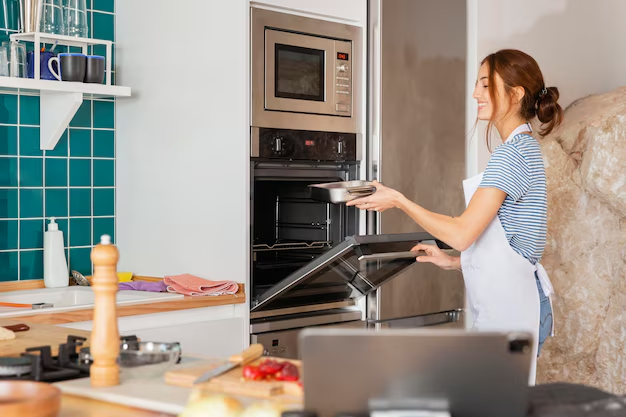How to Easily Adjust the Temperature on Your Samsung Refrigerator
In today's fast-paced world, having a reliable and efficient refrigerator is essential for maintaining fresh produce and safe food storage. Samsung, a renowned name in home appliances, offers a range of refrigerators designed to optimize food preservation with precision temperature control. But sometimes, adjusting these settings can seem daunting. Whether you're new to Samsung appliances or just looking for a refresher, understanding how to adjust the temperature on your Samsung refrigerator can enhance its functionality and ensure your food remains fresh.
Understanding Your Samsung Refrigerator's Display Panel
Before diving into the specifics of temperature adjustment, familiarize yourself with the display panel of your Samsung refrigerator. This panel acts as the command center, allowing you to control various settings seamlessly. It's typically located on the front of your refrigerator, often on the door.
Key Functions of the Display Panel
- Temperature Controls: Displays the current temperature settings of the fridge and freezer.
- Power Freezer and Power Cool: Quick-freeze and quick-cool options to rapidly achieve desired temperatures.
- Alarm Functions: Notifies you when the door is left open or if there's a temperature fluctuation.
Knowing where to find these controls and what each button represents can make the adjustment process more intuitive.
Steps to Adjust the Temperature
Adjusting the temperature on a Samsung refrigerator varies slightly depending on the model. However, the basic steps generally remain consistent across most digital models.
Step-by-Step Guide
Locate the Control Panel: Open the refrigerator door to access the control panel, located typically at the top.
Press the Fridge Button: To adjust the temperature of the refrigerator compartment, press the "Fridge" button. Each press generally changes the temperature by one degree. Samsung typically allows temperature settings ranging from 34°F to 44°F for the fridge compartment.
Press the Freezer Button: Similar to the fridge, pressing the “Freezer” button allows you to adjust the freezer's temperature. Most Samsung freezers offer settings between -8°F and 5°F.
Confirm the Settings: Once you have selected your desired temperatures, the settings will automatically confirm after a few seconds unless otherwise instructed by specific model guidelines.
Regularly Monitor the Display: Ensure temperatures are consistently set, especially during seasonal changes or after large food purchases.
Quick Tip: 🔄 Resetting Base Settings
If you suspect a malfunction or unresponsive controls, manually reset the refrigerator's default settings. Refer to your specific model's manual for detailed reset instructions.
Optimizing Temperature for Different Needs
Adjusting your Samsung refrigerator's temperature isn't just about keeping food cold. It's about optimizing conditions based on different factors like the types of food stored and ambient room temperatures.
Optimal Temperature Recommendations
- Fridge: Ideally set at 37°F to maintain food freshness and prevent bacterial growth.
- Freezer: Generally optimized at 0°F for effective long-term storage of frozen goods.
Seasonal Adjustments
Different weather conditions might necessitate temperature adjustments:
Summer: Increased external temperatures can affect internal cooling. Consider lowering the fridge and freezer temps by a couple of degrees.
Winter: Reduced ambient temperatures might allow for slightly higher operational temps without compromising food safety.
Common Troubleshooting Tips
Even with optimal settings, there might be times when your refrigerator doesn't operate as expected. Here are some common troubleshooting tips that can come in handy.
Diagnosing Uneven Cooling
- Obstructed Vents: Make sure air vents are unobstructed. Blocked vents can lead to uneven cooling.
- Overfilling: Avoid overcrowding the refrigerator, as it impedes air circulation and can cause temperature variances.
Maintaining Performance
- Regular Cleaning: Dust and vacuum the coils behind or beneath the refrigerator to maintain efficient cooling functionality.
- Door Seals: Ensure door seals are clean and intact to prevent cool air from escaping.
Enhancing Efficiency and Longevity
A Samsung refrigerator’s longevity and efficiency greatly depend on regular maintenance and optimal usage patterns. Here are some essential practices:
Regular Defrosting: Even if your Samsung refrigerator has an automatic defrost system, manually defrosting every few months can prevent ice build-up.
Energy-Saving Features: Use energy-saving modes when on vacation or during extended periods of absence to conserve energy.
Periodic Professional Consultation: Engage professional services annually to conduct a thorough inspection and address any subtle inefficiencies.
Key Takeaways for Ideal Temperature Management
Here's a simplified summary of the points discussed, enhanced with visual cues for better skimmability:
- 🌀 Regular Monitoring: Frequently check temperature settings and make gradual adjustments as needed.
- 🍎 Food Organization: Properly organize food items to enhance air circulation and even temperature distribution.
- 🔧 Quick-Fix Options: Utilize Power Freeze/Cool features for rapid temperature adjustments after large food deliveries.
- 🏠 Ambient Adjustment: Be responsive to external temperature changes, adjusting fridge settings accordingly.
Understanding how to adjust the temperature on a Samsung refrigerator empowers you to keep your food fresh, your appliances in peak condition, and your energy consumption in check. This balanced approach to managing refrigerator settings enhances both your kitchen efficiency and culinary enthusiasm, ensuring your appliances work as intended without unnecessary wear and tear. By staying attentive to these details, you can rest assured that your refrigerator is one less thing to worry about in your bustling home life.
